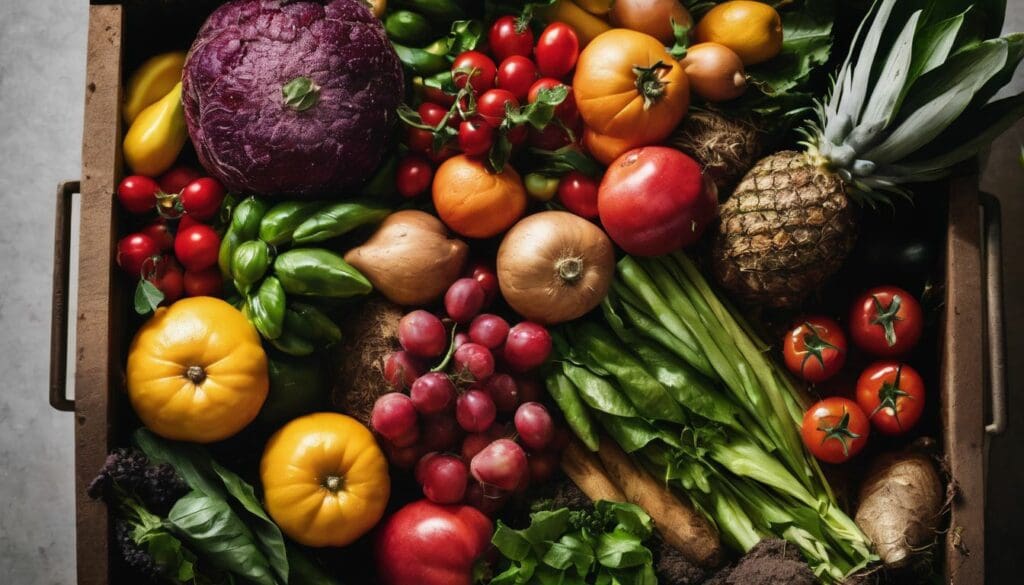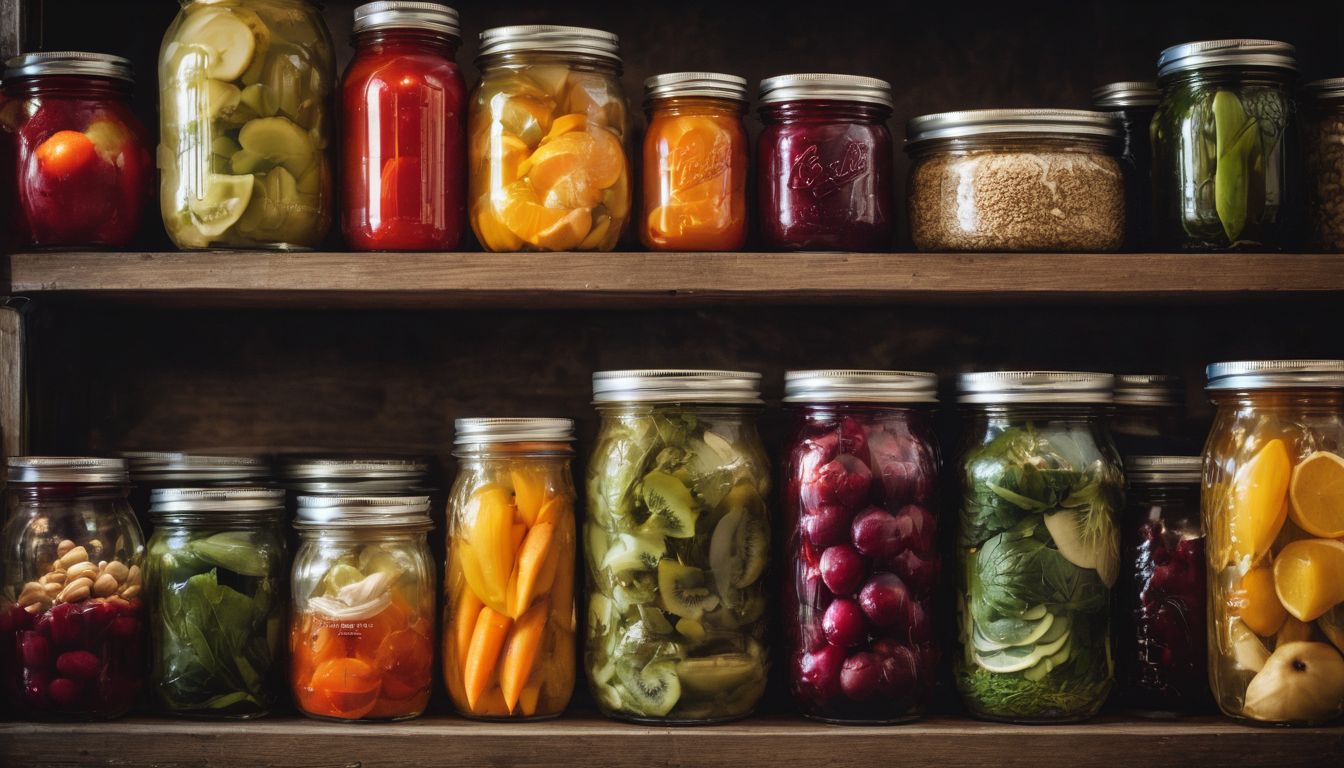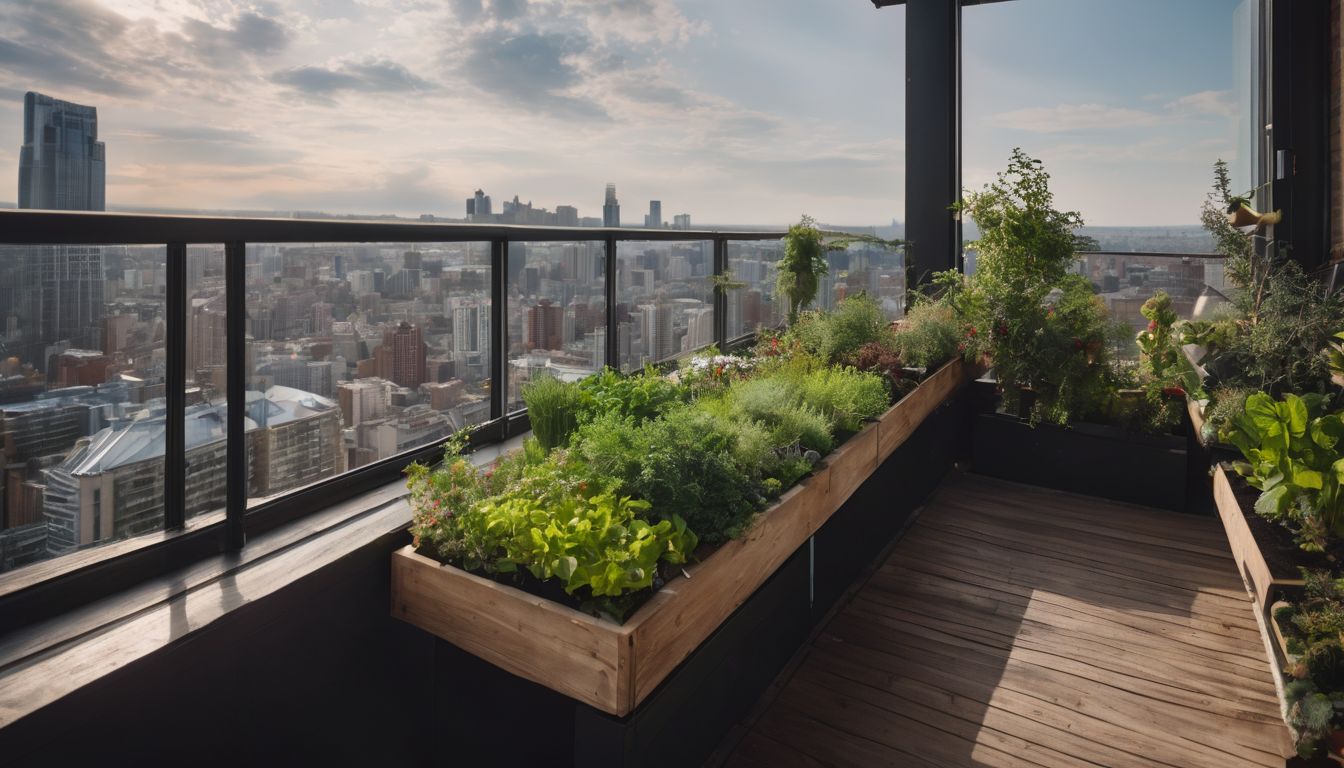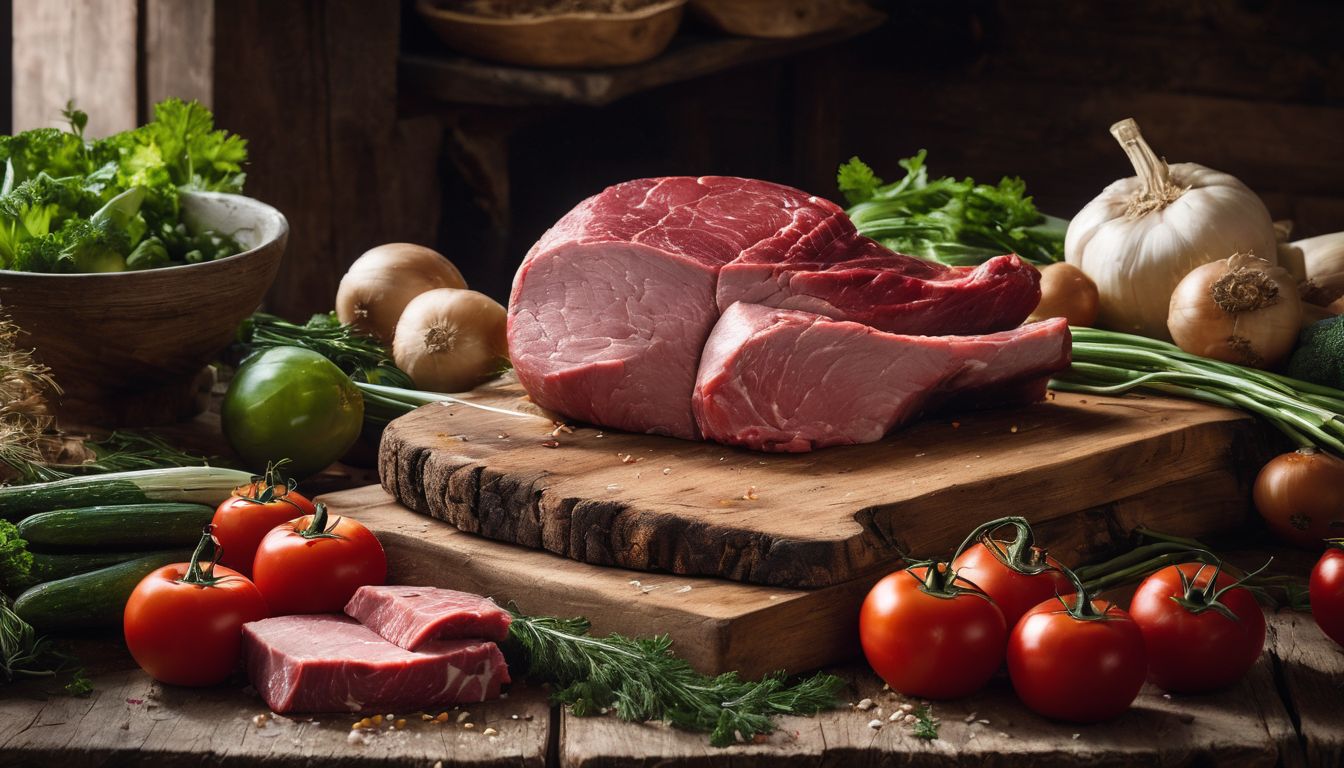Are you noticing how much food gets thrown out at home? Globally, we waste about a third of the food produced each year. Our guide to zero-waste cooking will show you how to turn peelings into plates and leftovers into lunches.
Let’s cook up a change!
Key Takeaways
- Zero – waste cooking minimises food waste by using every part of ingredients, planning meals effectively, repurposing leftovers, and composting organic scraps.
- Adopting zero – waste methods in the kitchen brings environmental benefits such as lowering carbon footprints and reducing landfill burden while encouraging healthier eating habits through fresh and whole foods.
- To get started with zero – waste cooking, bring reusable bags for shopping, purchase local produce to cut down on transportation emissions, store food correctly to extend freshness, and learn preservation techniques like canning or fermenting.
- Restaurants can impact the environment positively by adopting zero-waste practices which meet customer demands for sustainable dining options and help build a reputation as an eco-friendly brand.
- Individual efforts in zero – waste cooking combined with restaurant industry practices contribute significantly to conserving natural resources and promoting sustainability.
What is Zero-Waste Cooking?
Zero-Waste Cooking is a sustainable cooking approach that aims to minimize food waste by using all parts of ingredients, repurposing leftovers, and planning meals to reduce excess.
It benefits the environment and promotes healthier eating habits.
Definition and concept
Zero-waste cooking takes the concept of sustainable cooking to new levels by eliminating food waste completely. It revolves around using every part of the ingredients bought or grown, transforming peels, stalks and other traditionally discarded parts into delicious components of a dish.
This approach extends beyond recipes and includes mindful purchasing, preparation, and storage.
Embracing zero-waste cooking means thinking creatively about meal planning and turning what many see as scraps into nutritious meals. The goal is not just to reduce trash but also to maximise resources in an ecofriendly way.
By following this philosophy, each step—from selecting produce to repurposing leftovers—becomes an important aspect of ethical cooking designed to conserve natural assets and promote kitchen sustainability.
Benefits for the environment
Reduce your carbon footprint and lessen the burden on landfills by embracing zero-waste cooking practices. By minimising food waste, you can make a positive impact on the environment.
Conserving resources, reducing greenhouse gas emissions, and preserving biodiversity are just some of the benefits. Composting vegetable scraps and using every part of an ingredient not only minimises waste but also contributes to healthier soil for future crops.
Embracing eco-friendly recipes and sustainable food preparation techniques can significantly reduce your environmental impact. By adopting these practices, you can help protect natural resources and promote a more sustainable future for generations to come.
Benefits for health
Zero-waste cooking offers significant health benefits as it encourages the consumption of fresh, whole foods that are minimally processed and free from harmful additives. By minimizing food waste, individuals can also reduce their reliance on packaged and pre-prepared foods, which often contain high levels of preservatives and unhealthy additives.
Additionally, zero-waste cooking promotes mindful eating habits by emphasizing the use of seasonal ingredients that are rich in essential nutrients, thus supporting overall well-being.
Embracing a zero-waste approach to cooking can lead to reduced exposure to toxins commonly found in packaging materials and food containers. Furthermore, consuming locally sourced produce supports sustainable farming practices while providing access to fresh, nutritious ingredients.
How to Get Started with Zero-Waste Cooking
Start by planning your meals to avoid over-purchasing ingredients, repurpose leftovers into new dishes, and compost food scraps. When shopping, bring reusable bags and containers to minimise packaging waste, and learn how to properly store and preserve fresh foods.
Planning meals
When planning meals, consider using ingredients that can be used in multiple dishes to minimise waste. Choose recipes that utilise the entire vegetable or fruit, such as using broccoli stems in stir-fries or smoothies, and turning stale bread into croutons or breadcrumbs.
Try incorporating meal planning techniques to use up perishable items before they spoil. This can help reduce food waste and save money. By being mindful of portion sizes and preparing only what is needed, you can contribute to a more sustainable kitchen and support environmental conservation efforts.
To further minimise waste, explore zero-waste recipes that maximise the use of all parts of ingredients. Consider preserving foods through pickling, fermenting, or freezing excess produce for later use.
Repurposing leftovers
Repurposing leftovers is an essential part of zero-waste cooking. It not only reduces food waste but also saves money and contributes to sustainable living. Here are some simple ways to repurpose leftovers in your kitchen:
- Turn leftover vegetables into a delicious soup or stew by blending them with broth and seasoning.
- Use stale bread to make croutons, bread crumbs, or a savoury bread pudding.
- Transform cooked rice into fried rice, rice pudding, or rice cakes.
- Create a new meal by combining various leftover ingredients in a frittata or omelette.
- Repurpose meat and poultry leftovers into sandwiches, wraps, or salads.
Composting
To further reduce kitchen waste, consider composting. Composting is the process of breaking down food scraps and organic materials into nutrient-rich soil conditioner. It helps divert waste from landfills while creating a valuable resource for gardening and farming.
By composting fruit and vegetable scraps, coffee grounds, eggshells, and more, you can actively contribute to reducing environmental impact in your own home.
Composting also plays a crucial role in minimising greenhouse gas emissions associated with food decomposition in landfills. This simple yet effective practice aligns with sustainable kitchen principles, promoting eco-friendly cooking practices by completing the cycle of food use and ensuring that no part goes to waste.
Shopping with zero-waste in mind
To minimise waste when shopping, buy in bulk to reduce packaging. Bring your own reusable bags and containers to the store. Choose products with minimal or biodegradable packaging. Avoid single-use plastics and opt for glass or metal containers when possible. Look for local, seasonal produce to reduce transportation emissions and support the community. Purchase items from zero-waste stores or those committed to sustainable packaging. Be mindful of expiry dates and prioritise perishable goods to minimise food waste.
Proper food storage and preservation
After shopping with zero-waste in mind, it’s important to focus on proper food storage and preservation. This ensures that the food you bring home stays fresh for longer and reduces the chances of it going to waste. Here are some key ways to achieve this:
- Use airtight containers to store leftover foods, preventing them from spoiling and reducing the need for single-use plastic wrap.
- Employ reusable beeswax wraps or silicone lids to cover bowls or half-eaten fruits and vegetables, keeping them fresh for longer periods.
- Freeze excess produce for later use in meals or smoothies, preventing them from deteriorating in the fridge.
- Consider pickling or fermenting surplus vegetables and fruits, ensuring they stay edible for extended periods while adding unique flavours to dishes.
- Invest in a vacuum sealer to extend the shelf life of meats, fish, and cheese by removing air from their packaging.
Preserving your own foods
Preserving your own foods is an essential aspect of zero-waste cooking. It allows you to extend the shelf life of produce and minimise food waste. Here are some effective ways to preserve your own foods:
- Canning: Use mason jars to preserve fruits, vegetables, and sauces through a boiling water bath or pressure canning method.
- Fermentation: Harness the power of bacteria and yeast to create flavourful and nutritious fermented foods like sauerkraut, kimchi, and pickles.
- Dehydrating: Remove moisture from fruits, vegetables, and herbs to create long-lasting snacks or ingredients for future use.
- Freezing: Preserve seasonal produce by freezing them in airtight containers or bags for later use in smoothies, soups, or stews.
- Infusing: Create infused oils or vinegars using fresh herbs, spices, or citrus peels to add flavour to dishes while preserving excess ingredients.
The Importance of a Zero-Waste Kitchen
Reducing food waste, using all parts of food, and donating excess food are crucial practices in creating a sustainable and environmentally friendly kitchen. Learn more about the impact of zero-waste cooking by reading the full article.
Reducing food waste
Reducing food waste is crucial for environmental conservation. Use all parts of food, repurpose leftovers, and compost organic waste. Properly store and preserve food to minimise wastage.
Avoid overbuying by planning meals and shopping with zero-waste in mind.
Donating excess food contributes to reducing waste while helping those in need. Implement these practices for a more sustainable lifestyle, supporting the environment while enjoying the benefits of minimal waste cooking.
Using all parts of food
To practise zero-waste cooking, utilise all parts of food. Save vegetable scraps, such as carrot ends and onion skins, to make flavourful stocks or broths. Turn broccoli stems into a tasty slaw or transform citrus peels into zesty seasonings.
Embrace the creativity in using every edible part of ingredients to reduce waste and enhance sustainability in your culinary practices.
When embracing a zero-waste approach to cooking, think beyond traditional recipes and seek innovative ways to incorporate typically discarded parts of food into your dishes. This mindful use of ingredients not only minimises waste but also adds depth and complexity to your meals while contributing positively to environmental conservation efforts.
Donating excess food
When having surplus food, consider donating it to local community organisations or food banks. This practice helps reduce food waste and supports those in need. By donating surplus produce, canned goods, or packaged items, you can contribute to combating hunger while also minimising waste.
Engaging in the act of donating excess food aligns with the principles of zero-waste cooking and reflects an environmentally conscious mindset. It is a simple yet impactful way to make a positive contribution to both the environment and your local community.
The Impact of Zero-Waste Cooking on Restaurants
Implementing zero-waste cooking practices can help restaurants reduce their environmental footprint, meet customer demands for sustainable dining options, and build a reputation as a socially responsible and eco-friendly brand.
Importance for the environment
Reducing food waste is crucial for the environment. By embracing zero-waste cooking, you can significantly decrease the amount of organic matter that ends up in landfills. This translates to lower greenhouse gas emissions and less pressure on our already strained waste management systems.
Additionally, using all parts of food and repurposing leftovers reduces overall resource consumption and supports a more sustainable food system.
Implementing ecofriendly cooking practices at both home kitchens and restaurants helps preserve natural resources. It also encourages others to adopt similar methods, creating a ripple effect towards a more environmentally conscious society.
Meeting customer demands
Restaurants that embrace zero-waste cooking practices are meeting customer demands for environmentally conscious dining options. By offering waste-reducing menus and eco-friendly culinary techniques, these establishments cater to the growing number of consumers seeking sustainable food choices.
Embracing conservation cuisine not only enhances a restaurant’s brand as an eco-conscious business but also contributes to reducing overall food waste in the hospitality industry.
Customers today value transparency and ethical practices when it comes to their dining choices. Restaurants that prioritise zero-waste cooking meet these demands by providing meals that align with environmentally conscious values.
Building a sustainable brand
Restaurants can build a sustainable brand by incorporating zero-waste cooking practices. This involves sourcing ingredients from local suppliers to reduce carbon footprint, implementing composting and recycling programmes, and using every part of the food product to minimise waste.
By openly promoting these efforts and engaging with customers about their eco-friendly initiatives, restaurants can attract environmentally conscious individuals who support conservation and environmental sustainability.
Establishing a sustainable brand also involves sharing knowledge about zero-waste cooking techniques through social media platforms or hosting workshops. Communicating transparently about the restaurant’s commitment to minimal food waste management helps in building trust with patrons.
Conclusion
In conclusion, embracing zero-waste cooking can make a significant impact on the environment and our health. Planning meals, repurposing leftovers, and mindful shopping are key steps to start this eco-conscious culinary journey.
With small changes in our kitchen habits, we can contribute to reducing food waste and building a sustainable future for all.
FAQs
1. What is Zero-Waste Cooking?
Zero-waste cooking involves using eco-conscious culinary techniques to prepare meals without wasting food.
2. Why is zero-waste cooking important?
Zero-waste cooking helps reduce waste in the kitchen, making it a smart choice for the environment and your wallet.
3. Can I make delicious meals with zero-waste recipes?
Absolutely! Zero-waste recipes encourage creativity and can result in delicious dishes that use every part of the ingredients.
4. How do I start practising zero-waste cooking at home?
Begin by learning simple eco-conscious culinary techniques, planning your meals, and using all parts of your food to minimise waste in the kitchen.





